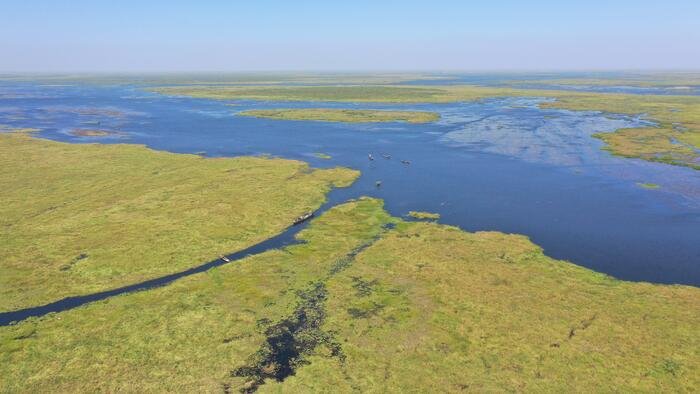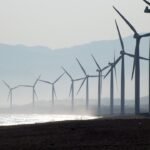Confronting Climate, Violence, and Insecurity with Tailored Solutions
BLERTA CELA
Director of the Regional Stabilization Facility, UNDP WACA
The Sahel region is faced with a convergence of challenges including droughts, floods, resource-related conflicts, insecurity from religious extremism, and forced population displacement. Blerta Cela, Director of the UNDP Regional Stabilization Facility for Liptako-Gourma and Lake Chad, emphasizes the importance of community-driven responses. Cela recognizes the complex interplay between climate and violence risks and advocates for targeted investments in on-the-ground responses to strengthen resilience and foster lasting peace in the Sahel.
The population in the Sahel region faces serious threats to their livelihoods and lives.
Solange, a farmer from Kassalare in Hadjer Lamis, Chad, was forced to flee her village in 2021 due to armed conflict. She and her family sought refuge in Baltram, where the Chadian government, through the Regional Stabilization Facility, supports the integration of displaced populations. Months after arriving in Baltram, Solange shared, “After working so hard on our land, it was difficult to leave. Fortunately, in Baltram, we felt welcomed. We were allocated land and provided with equipment to restart our agricultural activities. Today, cultivating maize and rice, I have regained the sense of normalcy we had in Kassalare. This gives me hope for our entire community.”
In the Sahel, where temperatures are rising 1.5 times faster than the global average, the region’s 50 million inhabitants, particularly women and girls who rely on livestock and agriculture, face increased risks. The escalation of extreme weather events further amplifies the dangers of disasters, jeopardizing the livelihoods of the most vulnerable. For example, in 2022, Chad experienced the heaviest rainfall in the last 30 years, displacing one million people and damaging over 465,000 hectares of farmland. Similarly, Niger has suffered devastating consequences from two years of flooding.
These climate change effects compound the challenges of violence related to banditry, inter-communal conflicts, and threats from religious extremism.
The effects of climate change interact with political and social pressures, accentuating existing vulnerabilities and tensions. In the Sahel, unfavorable climatic conditions, scarce land and water resources, and forced displacement of over 5.6 million people have intensified existing tensions, leading to conflicts such as those between migrating Fulani herders and indigenous Yoruba farmers in southwestern Nigeria.
In the Lake Chad region, insecurity and armed conflicts frequently hinder access to water, intensifying rivalries between farmers and herders in response to seasonal precipitation fluctuations.
Furthermore, studies from the Norwegian Institute of International Affairs and the Stockholm International Peace Research Institute indicate that climate change influences the decision-making, recruitment, and tactics of terrorist groups in the Sahel. These groups often target marginalized youth with economic and food incentives in exchange for loyalty. Religious extremism incidents in the Sahel account for 40 percent of all Islamist militant group activities in Africa, according to the African Center for Strategic Studies.
“Regional Stabilization Facility initiatives, which take into account the dynamics of climate change effects, provide communities with tools and solutions to secure their livelihoods, improve socio-economic conditions, and strengthen social cohesion in conflict-affected areas.”
– Blerta Cela, Director of the UNDP Regional Stabilization Facility for Liptako-Gourma and Lake Chad Regions
To ensure the success of stabilization activities, it is crucial to prioritize the expertise of local communities, as they are best positioned to contribute to response strategies. This is why local stabilization committees, which include many young people and women, play a central role in each intervention.
Regional Stabilization Facility initiatives, which consider the dynamics of climate change effects, provide communities with tools and solutions to secure their livelihoods, improve socio-economic conditions, and strengthen social cohesion in conflict-affected areas.
For instance, the regeneration of over 650 hectares of depleted soil on the Burkina Faso-Niger border has created spaces suitable for agricultural activities. In Cameroon, approximately 5,000 farmers, half of whom are women, have been trained in producing and using biopesticides. In Mali, the program has supported over 1,500 individuals with essential equipment for agriculture, livestock, and fishing, enhancing labor productivity, household incomes, and food security.
In Burkina Faso and Mali, the Facility has facilitated the construction of communal and agropastoral wells, expanding access to clean water and reducing waterborne diseases while diversifying agricultural production.
The installation of 3,700 solar streetlights across the Lake Chad and Liptako-Gourma basin, supported by the Facility, has enhanced security, particularly for women and girls.
By supporting host communities and flood-displaced populations in the Lake Chad basin, the Facility has contributed to addressing underlying grievances and mitigating conflict risks.
Since the inception of the program in 2019, over 435,000 internally displaced persons have returned to their villages. The Facility has been advancing a stabilization model in one of the world’s most complex contexts.
Maintaining and expanding these investments is crucial to reach more people, comprehensively address the complex interaction between climate change and violence, enhance resilience, and promote lasting peace in the Sahel region.
[1] OHCHR, Human Rights Climate Change and Migration in the Sahel, 2021, https://www.ohchr.org/sites/default/files/2021-11/HR-climate-change-migration-Sahel.pdf
[2] UNDP, Chad accelerates its race to adapt to climate change. What’s next?, 2023, https://www.undp.org/blog/chad-accelerates-its-race-adapt-climate-change-whats-next
[3] UNOCHA, Niger: Flash update – Inondations (au 11 Septembre 2023) https://reliefweb.int/report/niger/niger-flash-update-inondations-au-11-septembre-2023#:~:text=La%20r%C3%A9gion%20de%20Maradi%20est,personnes)%20sont%20les%20moins%20affect%C3%A9es
[4] OCHA, Sahel Humanitarian Overview (As of 16 October 2023)




